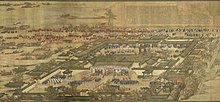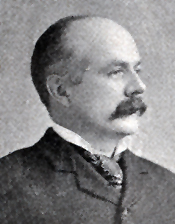한림학원
Hanlin Academy翰林院 | |
 | |
| 활동적인 | 708년 당 현종(uan宗) ~ 11년(소실) |
|---|---|
| 설립자 | 현종 |
| 위치 | |
| 한림학원 | |||||||
|---|---|---|---|---|---|---|---|
| 중국인 | 翰林院 | ||||||
| |||||||
한림학원은 8세기 당나라 현종이 장안에 세운 학문과 행정기관이다.
아카데미의 회원은 궁정에서 비서 및 문학 업무를 수행하는 엘리트 학자로 한정되었다.주요 업무 중 하나는 중국 고전의 해석을 결정하는 것이었다.이는 고위 관직에 오르기 위해 관료를 지망하는 관료가 합격해야 하는 과거시험의 토대가 되었다.궁정에서 일하는 화가들도 학원에 소속되어 있었다.
아카데미 회원
헨린의 유명한 학자는 다음과 같습니다.
- 이백(701년~762년)
- 백주이(白– (, 772년 ~ 846년) - 시인
- 연서(1書, 991년 ~ 1055년) - 시인, 서예가 (1042년)
- 구양수(100陽 xi, 1007년 ~ 1072년) - 역사학자
- 심국(沈國, 1031년 ~ 1095년) - 재상
- 장쩌단 (1085년 ~ 1145년) - 화가
- 자오멍푸 (1254년-1322년) - 화가, 서예가, 시인 (재임자, 1314년-1320년)
- 황제성(黃iche成, 1350년 ~ 1402년) - 황학
- 리동양 (1447년 ~ 1516년) - '대역사'로 활동한 황실 관리, 시인
- 니원루 (1593년-1644년) - 서예가, 화가, 고위 관리
- 우런첸 (1628년-1689년) - 역사가이자 수학자
- 천문글리(陳文i, 1650년 ~ 1741년) - 학자, 작가(구진투슈지청 편집장)
- 장팅위 (1672년-1755년) - 정치가이자 역사학자
- 지샤오란(1724년-1805년) - 학자, 시인(시쿠관수 편집장)
- 야오나이(31–, 1731년 ~ 1815년) - 학자
- 가오이 (1738년–1815년)– 학자 겸 편집자
- 하창링 (1785년–1848년)– 학자 및 관리
- 증국판(1811년-1872년) - 학자이자 이후 군 주요 관리
- 천란빈 (1816년 ~1895년)– 외교관 (미국, 스페인, 페루 대사)
- 붕둥허(–東河, 1830년~1904년) - 황실의 가정교사
- 차이위안페이(1868~1940) - 교육자
- 취홍지 (1850년-1918년) - 정치인
번역국
Hanlin Academy에 예속된 번역국(중국어: 夷四/四 pin; 병음:시이관/시이관; 웨이드-자일스: 스이관423/스이관443).[1]1407년 명나라에 의해 설립된 정화의 첫 인도양 원정 이후, 국은 외국 대사들과 외국어 전문가들에 의해 전달된 기념물들을 다루었다.그것은 Jurchen,[3][4][5]"타타르 말"(몽골)[6][7][8][9]Korean,[10]류큐 사람, Japanese,[11][12]Tibetan,[13] 같은 많은 languages[2]에"Huihui"부서(그"무슬림"언어, 페르시아)[14][15][6][16][17][18]Vietnamese[19]와 버마의 languages,[19][20]뿐만 아니라"다양한 야만인 부족들"의 언어(바이 의 百夷, 즉 포함했다중국 남서 국경에 샨 인종 집단),"Gaochang"(사람들이다.터판의, 즉,고대 위구르어)[6][17][21][22][23][24][25]와 시티아어(산스크리트어, 인도에서 사용).1511년과 1579년에 각각 [26]바바이(八 (; 라오스)와 태국어 학과가 추가되었다.말라카 술탄국에서 사용되는 말레이어를 위한 말레이어 어휘 목록(Manlajia Guan Yu)이 [27][28][29][30][31]작성되었다.참파왕국에서 [32][33]사용되는 언어를 위해 참어 어휘인 참어 어휘가 만들어졌다.
청나라가 명시관(明時官)을 부활시키자 야만인에 대한 언급에 민감했던 만주족은 이름을 '바리안'에서 '이족'으로 바꾸고, '백인'에서 '백인'[34]으로 바꿨다.
이후 청나라가 서양어를 번역하기 위해 세운 동문관은 한린이 아닌 종리야멘의 후예였다.
1900년 화재

베이징한린학원과 도서관은 1900년 간수 브레이브스가 8개국 동맹에 맞서 싸우다가 베이징(현재의 베이징)에 있는 국제공사관 공성전에서 큰 피해를 입었다.6월 24일, 불은 아카데미로 번졌다.
오래된 건물들은 굉음과 함께 불타오르고 있었고, 이는 동푸샹의 회교도들이 위쪽 창문에서 연기를 뚫고 마구 쏘아대자 머스킷총이 흔들리는 소리를 익사시켰다.
일부 소이탄은 격추됐지만 건물들은 불타고 있었고 주변에 서 있는 고목들은 횃불처럼 타올랐다.
유명한 영로타천을 구하려고 시도했지만, 많은 책이 파괴되어 그 시도는 포기되었다.
--
많은 고대 문서들이 [36]화염에 의해 소실되었다.
이 아카데미는 1911년 신해혁명 때 폐교될 때까지 계속 운영되었다.
「 」를 참조해 주세요.
레퍼런스
- ^ Wild, Norman (1945). "Materials for the Study of the Ssŭ i Kuan 四 夷 譯 館 (Bureau of Translators)". Bulletin of the School of Oriental and African Studies, University of London. 11 (3): 617–640. doi:10.1017/S0041977X00072311. JSTOR 609340. S2CID 154048910.
- ^ "ͼ ݹż 䱾 Կ". Archived from the original on 2013-10-19.
- ^ Shou-p'ing Wu Ko (1855). Translation (by A. Wylie) of the Ts'ing wan k'e mung, a Chinese grammar of the Manchu Tartar language (by Woo Kĭh Show-ping, revised and ed. by Ching Ming-yuen Pei-ho) with intr. notes on Manchu literature. pp. xix–.
- ^ Translation of the Ts'ing wan k'e mung, a Chinese Grammar of the Manchu Tartar Language; with introductory notes on Manchu Literature: (translated by A. Wylie.). Mission Press. 1855. pp. xix–.
- ^ de Lacouperie, Terrien (1889). "The Djurtchen of Mandshuria: Their Name, Language, and Literature". Journal of the Royal Asiatic Society of Great Britain and Ireland. 21 (2): 433–460. JSTOR 25208941.
- ^ a b c Morris Rossabi (28 November 2014). From Yuan to Modern China and Mongolia: The Writings of Morris Rossabi. BRILL. pp. 98–. ISBN 978-90-04-28529-3.
- ^ Shou-p'ing Wu Ko (1855). Translation (by A. Wylie) of the Ts'ing wan k'e mung, a Chinese grammar of the Manchu Tartar language (by Woo Kĭh Show-ping, revised and ed. by Ching Ming-yuen Pei-ho) with intr. notes on Manchu literature. pp. xxvi–.
- ^ Alexander Wylie; Henri Cordier (1897). Chinese Researches. pp. 261–.
termed 1407 certain number of students were appointed by imperial authority instructed in knowledge writing language tribes.
- ^ Translation of the Ts'ing wan k'e mung, a Chinese Grammar of the Manchu Tartar Language; with introductory notes on Manchu Literature: (translated by A. Wylie.). Mission Press. 1855. pp. xxvi–.
- ^ Ogura, S. (1926). "A Corean Vocabulary". Bulletin of the School of Oriental Studies, University of London. 4 (1): 1–10. doi:10.1017/S0041977X00102538. JSTOR 607397. S2CID 145363934.
- ^ Mai, Yun (2005). "漢語歷史音韻研究中的 一些方法問題 [Some Methodological Problems in Chinese Phonetics]". 浙江大学汉语史研究中心简报 [The Briefing News of Research Center for History of Chinese Language]. 18 (2). Retrieved 24 May 2020.
- ^ Chiu, Chichu (21 December 2012). 中國翻譯史學會論文投稿: 16世紀日本譯語的出版及傳抄 [The Publishing and Writing of Chinese-Japanese Dictionary in the 16th Century]. 書寫中國翻譯史:第五屆中國譯學新芽研討會 [Writing Chinese Translation History: Fifth Young Researchers’ Conference on Chinese Translation Studies] (in Chinese). Retrieved 24 May 2020.
- ^ Lotze, Johannes S. (2016). Translation of Empire: Mongol Legacy, Language Policy, and the Early Ming World Order, 1368-1453 (PDF) (PhD). Retrieved 24 May 2020.
- ^ Ido, Shinji (2018). "Chapter 2: Huihuiguan zazi: A New Persian glossary compiled in Ming China". Trends in Iranian and Persian Linguistics. De Gruyter Mouton. pp. 21–52. doi:10.1515/9783110455793-003.
- ^ Ido, Shinji (2015). "New Persian vowels transcribed in Ming China". Iranian languages and literatures of Central Asia: from the 18th century to the present. Association pour l’Avancement des Études Iraniennes. pp. 99–136.
- ^ Hecker, Felicia J. (1993). "A Fifteenth-Century Chinese Diplomat in Herat". Journal of the Royal Asiatic Society. 3 (1): 85–98. doi:10.1017/S1356186300003692. JSTOR 25182641.
- ^ a b Morris Rossabi (28 November 2014). From Yuan to Modern China and Mongolia: The Writings of Morris Rossabi. BRILL. pp. 94–. ISBN 978-90-04-28529-3.
- ^ 페이지 5
- ^ a b "Thông báo về việc các GS Nhật Bản sang trao đổi khoa học, tham gia đào tạo cao học Hán Nôm" (PDF). Archived from the original (PDF) on 2016-03-09. Retrieved 2016-01-22.
- ^ http://c.sou-yun.com/eBooks/ 파일/파일%20 파일%20 파일%20 파일/파일.pdf[베어 URL PDF]
- ^ Association for Asian Studies. Ming Biographical History Project Committee; Luther Carrington Goodrich (15 October 1976). Dictionary of Ming biography, 1368–1644. Columbia University Press. pp. 1042, 1126. ISBN 9780231038010.
- ^ Heinrich Julius Klaproth (January 1985). Abhandlung über die Sprache und Schrift der Uiguren. Buske Verlag. pp. 6–. ISBN 978-3-87118-710-0.
- ^ Heinrich Julius Klaproth (1820). Abhandlungen über die Sprache und Schrift der Uiguren. pp. 6–.
- ^ Heinrich Julius von Klaproth (1820). Abhandlung über die Sprache und Schrift der Uiguren, nebst einem Wörterverzeichnisse und anderen uigurischen Sprachproben (etc.). Königl. Dr. pp. 6–.
- ^ Heinrich Julius Klaproth (1812). Abhandlung über die Sprache und Schrift der Uiguren. pp. 41–.
- ^ Norman Wild (1945), "Materials for the Study of the Ssŭ i Kuan 四夷(譯)館 (Bureau of Translators)", Bulletin of the School of Oriental and African Studies, University of London, 11 (3): 617–640, doi:10.1017/s0041977x00072311, JSTOR 609340, S2CID 154048910; 페이지 617-1984.
- ^ Vladimir Braginsky (18 March 2014). Classical Civilizations of South-East Asia. Routledge. pp. 366–. ISBN 978-1-136-84879-7.
- ^ Edwards, E. D.; Blagden, C. O. (1931). "A Chinese Vocabulary of Malacca Malay Words and Phrases Collected between A. D. 1403 and 1511 (?)". Bulletin of the School of Oriental Studies, University of London. 6 (3): 715–749. doi:10.1017/S0041977X00093204. JSTOR 607205. S2CID 129174700.
- ^ B., C. O. (1939). "Corrigenda and Addenda: A Chinese Vocabulary of Malacca Malay Words and Phrases Collected between A. D. 1403 and 1511 (?)". Bulletin of the School of Oriental Studies, University of London. 10 (1). JSTOR 607921.
- ^ Phyllis Ghim-Lian Chew (7 December 2012). A Sociolinguistic History of Early Identities in Singapore: From Colonialism to Nationalism. Palgrave Macmillan. pp. 79–. ISBN 978-1-137-01233-3.
- ^ Donald F. Lach (15 January 2010). Asia in the Making of Europe, Volume II: A Century of Wonder. Book 3: The Scholarly Disciplines. University of Chicago Press. pp. 493–. ISBN 978-0-226-46713-9.
- ^ Edwards, E. D.; Blagden, C. O. (1939). "A Chinese Vocabulary of Cham Words and Phrases". Bulletin of the School of Oriental Studies, University of London. 10 (1): 53–91. JSTOR 607926.
- ^ Vladimir Braginsky (18 March 2014). Classical Civilizations of South-East Asia. Routledge. pp. 398–. ISBN 978-1-136-84879-7.
- ^ 야생(1945), 페이지 620.
- ^ "BOXER REBELLION // CHINA 1900". HISTORIK ORDERS, LTD WEBSITE. Archived from the original on February 12, 2005. Retrieved 2008-10-20.
- ^ Diana Preston (1999). The Boxer Rebellion: The Dramatic Story of China's War on Foreigners That Shook the World in the Summer of 1900. pp. 138–140. ISBN 0-8027-1361-0.
추가 정보
- Martin, William Alexander Parsons (1880). Hanlin Papers: Or, Essays on the Intellectual Life of the Chinese. Trübner & Company. Retrieved 24 April 2014.
- Sparks, Jared; Everett, Edward; Lowell, James Russell; et al., eds. (1874). The North American Review, Volume 119. American periodical series, 1800-1850. O. Everett. Retrieved 24 April 2014.
외부 링크
외국어 어휘
- Wikisource: zh: 몽골어
- 태국어
- 미얀마어
- 大 ((대산) - 大山(대산)
- 大 ((대산) - 大山(대산)
- 페르시아어
- 페르시아어
- 고대 위구르어
- 티베트어
- 티베트어
- Wikisource: zh: 한국어
- Wikisource:zh:Manager(Wikisource)#.E5.A4.B7.E8.AA.9EEF.BC.88.E9.99.84.EF.BC.89 류큐어
- Wikisource:zh:Manager(Manager)/manager#.E5.A4.B7.E8.AA.9E – 류큐어
- wikisource : zh : 琉夏 ( 陽夏 ) / wikisource # 。E5.A4.B7.E8.AA.9EE3.80.90.E9.99.84.E3.80.91 류큐어
- Wikisource: zh: uan卷卷 / 六# # . E9 . A2 . A8 . E4 . BF . 97 Ryukyuan 언어
- Wikisource: zh: 류큐어
- 류큐어
- 0-★★★★★★★ 2014-11-29 Wayback Machine 류큐언어로 아카이브 완료
- 류큐어
- Wilhem Grube의 Die Sprache und Schrift der Juchen: [1] 여진어


